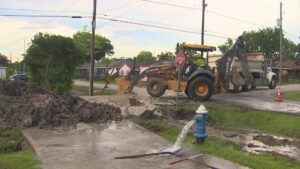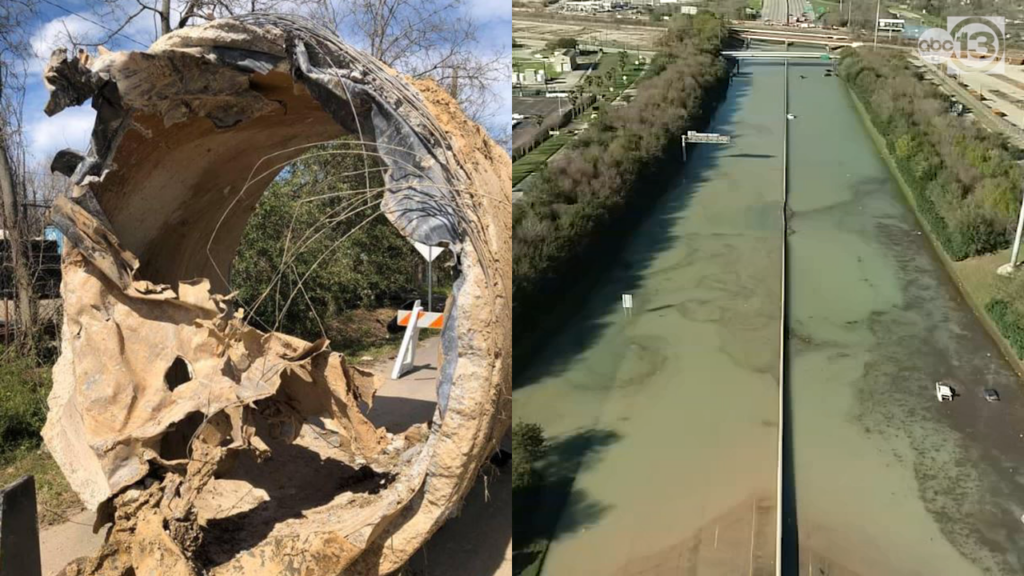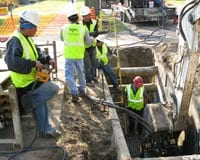In today’s rapidly advancing society, there is a prevailing tendency to focus on groundbreaking designs and innovative technologies for new developments, often overshadowing the pressing issue of decaying existing infrastructure. The allure of exploring uncharted territories and constructing new master-planned communities often takes precedence over addressing the deteriorating foundations beneath our cities. Throughout the Houston region, aging water infrastructure is already causing issues for some communities and will become an issue for hundreds of thousands of more people in the years ahead.

Drought conditions leading to water leaks in Houston (2022)
The greater Houston region has had several wakeup calls in the recent past. The 2011 drought was especially eye opening to many public officials and residents causing a call to action. 12 years later the drought of 2023 has reinvigorated this call with the hope of getting some traction. These natural phenomenon’s revealed a crumbling waterline system constructed with archaic materials designed to last approximately 50 years. Much of this system has surpassed its shelf life with many other areas, quickly reaching that 50-year mark. The problems with our water infrastructure has a distinct way of making itself known, such as driving through large puddles when there has been no recent rains or seeing water gushing into the air. While the excitement of focusing on what’s new may be enticing, it is essential to recognize the critical importance of addressing the foundational infrastructure that supports our communities before problems happen.

Water line shows damage from E. Loop flood (2020)
Over the past fifty years, major water leaks and system disruptions have been sporadic. More recently, there has been a surge in water main breaks across the Houston region. The contraction of coastal clay soils plays a significant role, causing joints on waterlines to separate and shift, placing additional stress on the aging pipes. The breaking point occurs during long-overdue rainstorms, when the rapid expansion of the soil reverses the stress on the pipes, resulting in cracks and ruptures. Our region’s streets have become a stage for Old Faithful, showcasing the vulnerability of our aging water infrastructure.
It is becoming increasingly evident that our water infrastructure is in a downward spiral. Advocacy for water conservation and surface water usage over groundwater is important, but it is more crucial to address the extraordinary water loss caused by the current state of water infrastructure. In 2023 alone, the City of Houston reportedly lost over 9 billion gallons of water between January and April, due to main breaks and other water system failures. Older Municipal Utility Districts are in a prime position to heed the warning that was witnessed during the 2023 drought. A call to action needs to be a top priority to District consultants who manage this older infrastructure.
In response to this crisis, innovative construction techniques have emerged, offering a solution to the decaying water infrastructure. New technologies such as pipe bursting or directional drilling, stand out as a viable option. These methods limit the surface level disturbance and allow for working in tighter spaces using PVC and HDPE pipe. These modern materials boast an estimated shelf life of over 100 years, significantly outlasting their outdated counterparts. Implementing such projects would not only be at the forefront of conservation efforts but would also play a pivotal role in delivering water efficiently to its destination, in turn alleviating stress on water production facilities.
Furthermore, addressing water infrastructure challenges through trenchless construction would have broader implications. It could limit issues related to boil water notices, mitigate damage to roadways and trails caused by water main breaks, and enhance general landscaping efforts around the region. By proactively embracing these solutions, the region can not only modernize its water distribution systems but also contribute to the overall sustainability and resilience of the community.
The decaying state of water infrastructure across the Houston region demands urgent attention and action. The repercussions of neglecting this issue extend beyond visible disruptions in the form of water main breaks; they manifest in significant water losses which pose enduring challenges for the community. Embracing innovative solutions, such as pipe bursting, not only offers a timely response to the immediate crisis but also lays the groundwork for a more sustainable and resilient future for our region.
It is now more crucial than ever to prioritize the renewal of our water infrastructure. By doing so, we not only safeguard against the current vulnerabilities but also contribute to the ongoing well-being and prosperity of our communities. In this collective effort, we can transform the challenges we face into opportunities for lasting positive change, ensuring a reliable and efficient water distribution system that sustains our city for generations to come.
 Written by Taylor Reed, P.E.
Written by Taylor Reed, P.E.
Water Resources Committee
Published February 5, 2024

